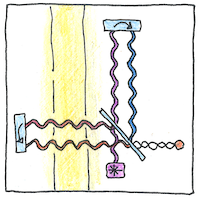Richard A. Isaacson,
Rainer Weiss,
Kip Thorne,
Barry C. Barish
astrophysics

|
LIGO
The Laser Interferometer Gravitational-Wave Observatory detects gravity waves using laser interferometry and has launched a new branch of astronomy detecting the origin of collapsed binary systems, two black holes or neutron stars circling and merging into one. LIGO is able to detect gravitation waves with a sensitivity of under ten-thousandth of the diameter of a proton, and can locate astronomical events using observatories in Hanford Washington and Livingston Louisiana. Future gravitational-wave observatories in western India and western Australia, in addition to the gravitational-wave detectors in Sarstedt Germany, Cascoma Italy, and Gifu Prefecture Japan, will complete a global network that can act together to detect supernovae, rotating neutron stars, or more exotic events undetectable by other means.
Infinite sea of spacetime
We used to believe in gravity; we thought it was a force acting between two bodies. Now we know it’s just a side effect of distortions of spacetime caused by bodies with mass, and that spacetime is like a liquid that can be disturbed by sudden movements. We even used to say “the fabric of spacetime,” but now we know it’s four-dimensional. It’s not like the surface of a lake, but like being submersed in an infinite sea. Try not to think of a wave on a surface; think instead of an explosion that makes a noise underwater. Spacetime is disturbed not only by masses in motion but by its own disturbances, pushing and pulling itself.
Gravity dilates time
A clock high above earth runs faster than an identical clock on the ground. This is a metaphor for inebriation and fantasy. Boring conversations last longer the closer you get. Could it be that the psychology of Earthlings is related to the general relativity, or could this be only a coincidence?



Each arm of the LIGO laser interferometer at Hanover is four kilometers long. Extraordinary engineering has been required to keep it still. Even though it is 250 miles from the Pacific Ocean, they say in a storm that the device can hear ocean waves crashing on the rocks.
See also in The book of science:
Readings in wikipedia:
Other readings: